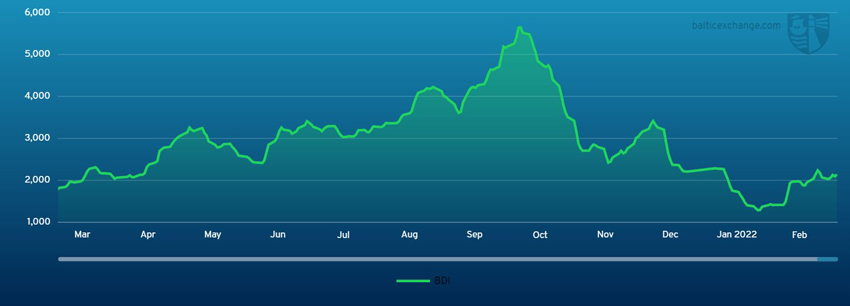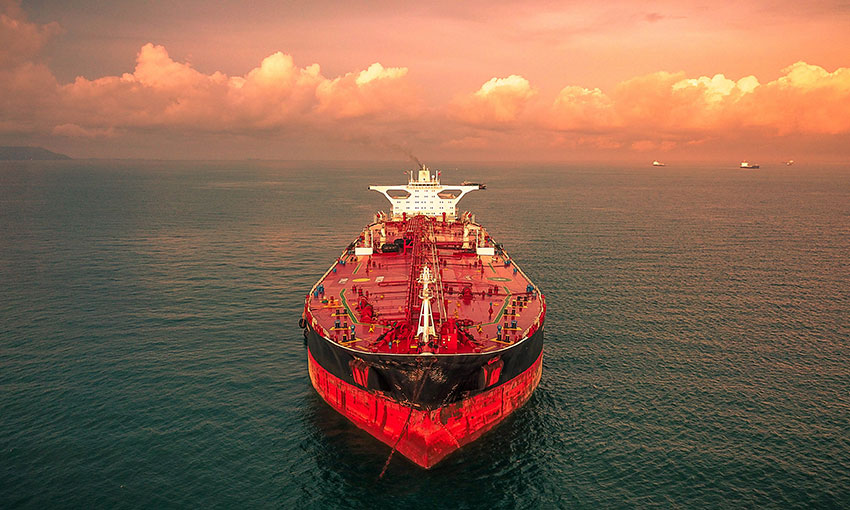THE Baltic Dry Index last week saw a slight incline, ending the week higher than it started.
The BDI for Friday 4 March was 2148, an increase of 3.5% on the previous Friday (when the BDI was at 2076).

Capesize
The Capesize market had a mild trading range this week hitting a high of US$15,258 and a low of US$13,414 to settle Friday at US$13,560.
While events in Europe have been disruptive, the trading activity was generally back to normal this week as most shipping routes are business as usual – albeit without the Black Sea trade routes.
The Pacific was definitely the more volatile region with the transpacific C10 swinging positive by weeks end to US$13,008.
In comparison, the Transatlantic C8 was stable but softening throughout to close at US$14,425. The Ballaster route C14 continues to trade at a discount at US$8,845.
Most voyage routes have seen solid gains this week. However, the underlying timecharter equivalent values have been battling to maintain parity as bunker levels have been rallying strongly with volatile swings.
The crisis in eastern Europe continues to be a sharp focus for all shippers both from a commercial risk and operational viewpoint. Trade flows from the region remain in limbo with many owners now giving it a wide berth.
Panamax
The market started slowly this week with many still observing and working out implications from events in Ukraine. Many ships open in the Black Sea or East Mediterranean were forced to seek alternative employment, which at first appeared to negatively impact market for the early part of the week. However, momentum was built midweek – especially on the fronthaul trips ex South America – whilst transatlantic mineral demand was slow, route P1A duly came off as a result.
Asia, by contrast, grew in strength. Indonesia saw solid levels of coal demand. And by Thursday we saw further support with NoPac grain stems and coal ex Australia into India coming to the market, ending the week on a positive note.
Period rates began to rally in line with FFAs and previous confidence prior to recent events with talk of several being placed by grain houses. Unconfirmed reports had a Kamsarmax fixing at US$30,000 for one year.
Ultramax/Supramax
Undoubtedly an unprecedented week in recent times with the situation in Ukraine. Most owners are now unwilling to trade towards the Black Sea region and many vessels are leaving the area where possible. Brokers said that even from the Asian arena there was a reluctance from some to trade back to the Atlantic preferring to stay within Asia.
Limited Atlantic business surfaced, but an ultramax was said to have been fixed from West Mediterranean to North Coast South America at US$13,000.
By contrast, sentiment remained strong from Asia and the Indian Ocean regions. More enquiry was seen from Indonesia, a 61,000-dwt open Makassar fixing a trip via Indonesia redelivery Japan at US$42,500.
From the Indian Ocean, a 63,000-dwt was heard fixed delivery Kandla trip via Beira redelivery East Coast India at US$33,000. Limited period activity surfaced but a 63,000-dwt open US Gulf beginning March was heard fixed for two to three laden legs redelivery Atlantic at US$30,500.
Handysize
The Atlantic continues to soften with the ongoing Ukraine situation being closely monitored and a general lack of fresh enquiry across the board.
A 37,000-dwt open US Gulf fixed a trip to the Continent at US$14,750 with an intended cargo of wood pellets.
By contrast, Asia is firming day on day with a lack of tonnage. A 39,000-dwt failing on subjects due to stow issues for a trip from Japan to Turkey at US$50,000 with an intended cargo of containers. A 38,000-dwt was placed on subjects for a trip from Japan to the US Gulf at US$46,000. Period remains active with a 32,000-dwt open Japan fixed for five to seven months with worldwide redelivery at US$30,000. Another 32,000-dwt open Vietnam fixed for minimum three to about five months with worldwide redelivery at US$32,000. A 35,000-dwt open in the East Mediterranean was fixed for four to six months with Far East redelivery at US$22,000.
Clean
The CPP tanker market has improved this week highlighted by the BCTI rising from 696 to 991, the highest it’s been since May 2020.
In the Middle East Gulf the LRs have seen a significant jump in freight, which has been long awaited by owners. On the LR2s, TC1s upward trend has led to the Index arriving at WS150 (+69.29). The LR1s have also taken advantage of this firming sentiment and TC5 55k Middle East Gulf/Japan has seen a 72.86 point jump to WS177.5.
On a trip to the UK Continent the LR1s have also jumped from US$1.7m to US$2.63m. The MRs of TC17 have not risen to the same magnitude as the LRs. However, if current trend continues we could see this occurring going into next week.
West of Suez, on the LR2s, TC15 80k Mediterranean/Japan has, as in the Middle East, spiked this week from US$1.85m to US$3.03m improving the round trip TCE from -15,131 to -2258 US$/day.
The LR1s, TC16 60k Amsterdam/Offshore Lomé, after dipping to around WS97.5 midweek returned upwards settling at WS135 at time of writing. On the UK-Continent, MR freight has modestly ticked up (around 10 WS points) in comparison to other regions. TC2 is currently marked at WS150 and TC19 WS156.43. Mixed reactions in the Americas this week. TC14 38k US Gulf/UK-Continent is up again and now WS 173.57 (+WS23.57) and TC18 stable for an MR US Gulf/Brazil run at WS216.79 (+2.5).
The Baltic Handymax markets have both risen this week but to different extents. TC9 30k Baltic/UK-Continent is now WS416.43 (+180) and a round trip TCE of US$47,386 /day and still reported as firm, for the moment. In the Mediterranean TC6 30kt Skikda/Lavera has only come up 22.5 points to WS280.
VLCC
The continuing war in Ukraine has held the focus of nearly all markets this week. And with so much uncertainty about what the future holds, all markets have come under significant pressure.
Rates for 280,000mt Middle East Gulf/USG (via Cape of Good Hope) have risen four points to WS26, while on the 270,000mt Middle East Gulf/China route rates jumped to WS59 early on and have now settled back to the WS55 level (a round trip TCE of US$5700 per day) – up 10 points from a week ago.
In the Atlantic region, the 260,000mt West Africa/China rose to WS57 at the beginning of the week with a number of vessels going on subjects. These have subsequently failed and rates have now slipped back to just under WS55 (a round-trip TCE of US$4900 per day), but still a five point gain for the week. The 270,000mt US Gulf/China trip peaked early in the week at US$6.7m. However, with the vessels released from their West Africa fixtures, and able to look at alternatives, the rate is now assessed at just over US$6.1m (a round-trip TCE of minus US$1,100 per day) representing a drop of US$131,000 from last week.
Suezmax
Sanctions on Russia have caused uncertainty across the Baltic Exchange routes, most profoundly in the Black Sea. The 135,000mt Black Sea/Augusta route has leapt 61.5 points to WS291 (a round-trip TCE of US$149,596 per day).
Owners willing to perform this voyage understandably now commanded a hefty premium. Rates for 130,000mt Nigeria/UKC, meanwhile, have been on a downward trajectory having peaked last Friday afternoon at WS117 and have now fallen to WS94 (a round-trip TCE of US$11,200 per day).
For the 140,000mt Basra/West Mediterranean route owners have managed to increase the market by 12 points to WS59. There are reports today of Litasco releasing subjects at the WS75-80 level for a 22 March loading from Basra. Turkish refiners are reported on subjects at WS55 with a Trafigura relet for a Basra/Turkey voyage loading 18th March.
Aframax
The Europe-centric Aframax market has had a tempestuous week at best. The 80,000mt Ceyhan/Mediterranean market rose 16.5 points to WS240 (a round-trip TCE of US$63,400 per day).
In Northern Europe, the rate for 80,000mt Hound Point/UKC has shot up almost 60 points to WS235 (a round-trip TCE of US$84,600 per day). In the 100,000mt Baltic/UKC market, rates are a staggering 196 points firmer at WS515 (a round-trip TCE of US$240,700 per day). This is as a result of the limited number of vessels able to load in Russia to discharge in Europe that are capable of transiting the ice region. There are reports today of WS550 being on subjects and only one Aframax remaining in a workable position for the next Baltic loading.
On the other side of the Atlantic, the market plateaued for the first few days of the week and has now started a descent. The rate for 70,000mt EC Mexico/US Gulf has fallen three points to WS167 (a round-trip TCE of US$19,800 per day). The 70,000mt Caribbean/US Gulf rates have slipped 1.5 points to the WS161 level (a round-trip TCE of US$15,500 per day). For the transatlantic route, the rate for 70,000mt US Gulf/UK Continent eased 5.5 points to WS147.5 (US$12,600 per day round-tip TCE, or significantly better basis one-way economics).

